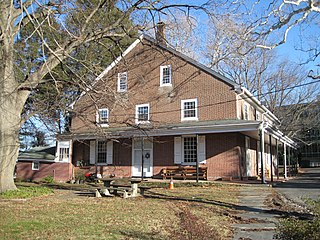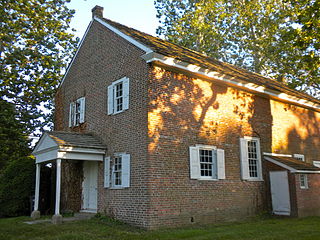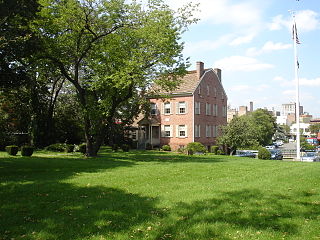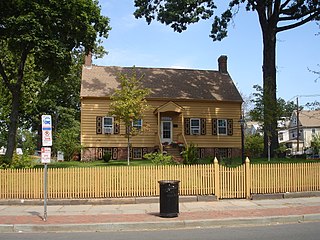
Mauricetown is a census-designated place and unincorporated community that is part of Commercial Township in Cumberland County, in the U.S. state of New Jersey.

The William Trent House is a historic building located at 15 Market Street in Trenton, Mercer County, New Jersey. It was built in 1719 for William Trent and is the oldest building in Trenton. He founded the eponymous town, which became the capital of New Jersey. It has served as the residence for three Governors. The house was added to the National Register of Historic Places and listed as a National Historic Landmark on April 15, 1970, for its significance as an example of Early Georgian Colonial architecture.

48 Hudson Avenue is the oldest building in the city of Albany, New York. It was believed by Paul Huey, in the Albany architectural guide of 1993, to have been built in 1759 by Johannes Radliff when he married Elizabeth Singleton because he believed it was built after the stockade was moved south by one block. Research done by Albany historian John Wolcott proved that it had been occupied by Johannes van Ostrande between 1728 and 1734 and that a mortgage Radliff had on the house referred to it as "formerly van Ostrande." The Lamont–Doherty Earth Sciences laboratory of Columbia University performed dendrochronology on a wood core sample from the building to confirm that the building dated from 1728. It has been listed on the National Register of Historic Places since January 10, 2008; prior to that, it had been a contributing property to the Downtown Albany Historic District.

The Brinkerhoff–Demarest House is located at 493 Teaneck Road in the township of Teaneck in Bergen County, New Jersey, United States. The historic stone house was documented by the Historic American Buildings Survey (HABS) in 1936. It was added to the National Register of Historic Places on January 10, 1983, for its significance in architecture. It was listed as part of the Early Stone Houses of Bergen County Multiple Property Submission (MPS).

The Woodbury Friends' Meetinghouse is located at 120 North Broad Street in the city of Woodbury in Gloucester County, New Jersey, United States. The Friends meeting house was built in 1715 and was documented by the Historic American Buildings Survey (HABS) in 1936. It was added to the National Register of Historic Places on February 6, 1973, for its significance in architecture and religion.

Alloways Creek Friends Meetinghouse is a historic Quaker meeting house on Buttonwood Avenue, 150 feet west of Main Street in the Hancock's Bridge section of Lower Alloways Creek Township in Salem County, New Jersey, United States. It was built in 1756 and documented by the Historic American Buildings Survey. It was later added to the National Register of Historic Places on December 18, 2003, for its significance in architecture.

St. John's Parsonage is a historic house at 633 Pearl Street in Elizabeth, Union County, New Jersey, United States.

Seven Stars Tavern is a historic building located at the junction of Sharptown-Swedesboro Road and Woodstown-Auburn Road in Pilesgrove Township of Salem County, New Jersey and near Woodstown. The building was built in 1762 and was added to the National Register of Historic Places on May 17, 1976, for its significance in architecture, military, and social history. It is now a private residence.

The Belcher–Ogden Mansion; Benjamin Price House; and Price–Brittan House Historic District is a 0.75-acre (3,000 m2) historic district located on East Jersey Street in Elizabeth, Union County, New Jersey, United States. It was added to the National Register of Historic Places on August 28, 1986, for its significance in architecture and exploration/settlement. It is located near Boxwood Hall and is in the heart of colonial Elizabethtown, the first English-speaking settlement in what became the Province of New Jersey.

The James Whitall Jr. House is located at 100 Grove Avenue in the borough of National Park, Gloucester County, New Jersey. The house was built in 1766 and documented by the Historic American Buildings Survey (HABS) in 1937. It was added to the National Register of Historic Places on February 6, 1973, for its significance in architecture.

Ladd's Castle, also known as Candor Hall, is a historic house located at 1337 Lafayette Avenue in the Colonial Manor section of West Deptford Township in Gloucester County, New Jersey. It was added to the National Register of Historic Places on October 31, 1972, for its significance in architecture and urban planning.

The Thomas Maskel House is located on Bacon's Neck Road near the Greenwich section of Greenwich Township in Cumberland County, New Jersey, United States. The building was documented by the Historic American Buildings Survey (HABS) in 1939. It was added to the National Register of Historic Places on June 10, 1975, for its significance in exploration/settlement.

The Greenwich Historic District is a 350-acre (140 ha) historic district located in the Greenwich section of Greenwich Township in Cumberland County, New Jersey, United States. It extends from the Cohansey River north toward the neighboring settlement of Othello. The district was added to the National Register of Historic Places on January 20, 1972, for its significance in agriculture, architecture, commerce, and politics. It includes 19 contributing buildings, many documented by the Historic American Buildings Survey (HABS).

Dickinson House is located on Brickyard Road in Alloway Township of Salem County, New Jersey, United States. The house was built in 1754 and was documented by the Historic American Buildings Survey (HABS) in 1939. The house was added to the National Register of Historic Places on February 20, 1975, for its significance in architecture.

Rancocas is an unincorporated community located within Westampton Township in Burlington County, New Jersey. The name derives from the Native American word Rankokous, which was used in the name of the Powhatan Lenape Nation Indian Reservation located in Westampton Township. The name was also known as a sub-tribe of the Ancocus. The Reservation was a popular tourist destination for visitors from the Philadelphia area, New York, and local residents, before the Reservation became Rancocas State Park.

The John Smith House is a historic building located at 124 Washington Valley Road in the Washington Valley section of Morris Township in Morris County, New Jersey, United States. It was documented by the Historic American Buildings Survey (HABS) in 1937. The house was added to the National Register of Historic Places on January 1, 1976, for its significance in agriculture and architecture. It was designated a contributing property of the Washington Valley Historic District on November 12, 1992.

The Thatcher House is a historic patterned brick house located at 255 Ridge Road in Kingwood Township, about two miles from Frenchtown, in Hunterdon County, New Jersey, United States. It is named after Jeremiah Thatcher, a local farmer. Built in 1765, the house was added to the National Register of Historic Places on December 4, 2020, for its significance in architecture. It features patterned brickwork with complex diamonds. The house is part of the Traditional Patterned Brickwork Buildings in New Jersey Multiple Property Submission (MPS). It features a mix of Flemish bond and Flemish checker, with four different diamond designs.

The John Reading Farmstead is a historic house located at 76 River Road by the South Branch Raritan River in Raritan Township, near Flemington in Hunterdon County, New Jersey. It was built in 1760 for John Reading, former governor of the Province of New Jersey, 1757–1758. The house was added to the National Register of Historic Places on November 21, 1978, for its significance in agriculture, architecture, politics, and exploration/settlement.

The Bishop–Irick Farmstead is a historic farmhouse at 17 Pemberton Road in the Vincentown section of Southampton Township of Burlington County, New Jersey. It was added to the National Register of Historic Places on August 4, 1992, for its significance in agriculture, architecture, and politics/government. It is now used as the headquarters of the Pinelands Preservation Alliance.

The Joseph Ware House, also known as the Joshua Thompson House and the Ware–Shourds House, is a historic house located at 134 Poplar Street in the Hancock's Bridge section of Lower Alloways Creek Township in Salem County, New Jersey. It was added to the National Register of Historic Places on January 26, 1990, for its significance in architecture, exploration/settlement, literature, military history, and politics/government.
























